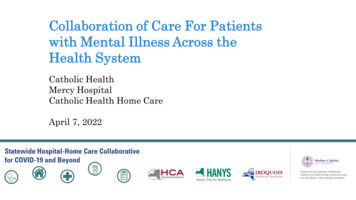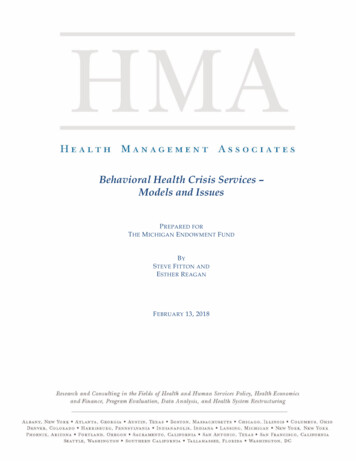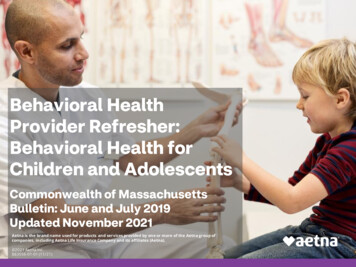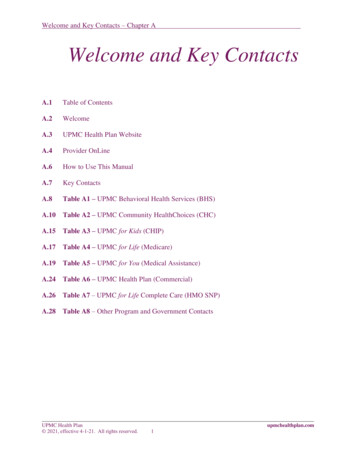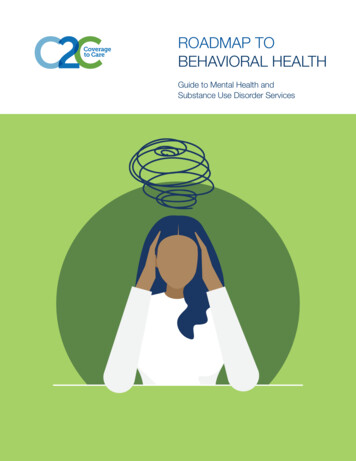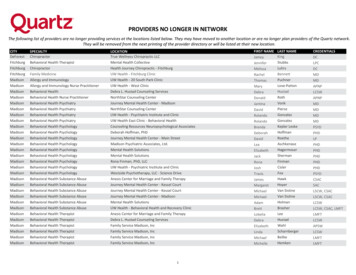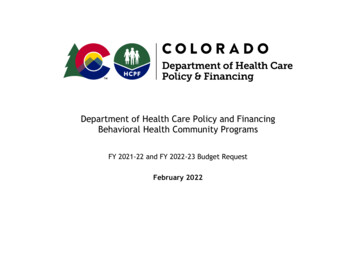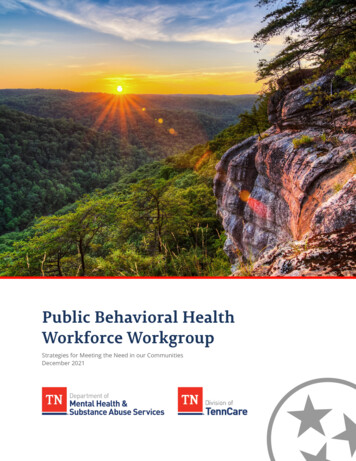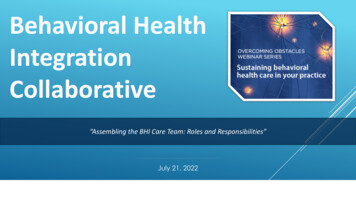
Transcription
Behavioral HealthIntegrationCollaborative“Assembling the BHI Care Team: Roles and Responsibilities”July 21, 2022 2020 American Medical Association. All rights reserved.
DISCLAIMER AND NOTICESThis Webinar is being made available to the general public and is for informational purposes only. The viewsexpressed in this Webinar should not necessarily be construed to be the views or policy of the AMA.The information in this Webinar is believed to be accurate. However, the AMA does not make any warrantyregarding the accuracy or completeness of any information provided in this Webinar. The information is providedas-is and the AMA expressly disclaims any liability resulting from use of this information. The information in thisWebinar is not, and should not be relied on as, medical, legal, or other professional advice, and viewers areencouraged to consult a professional advisor for any such advice.No part of this Webinar may be reproduced or distributed in any form or by any means without the prior writtenpermission of the AMA.All rights reserved. AMA is a registered trademark of the American Medical Association.2 2020 American Medical Association. All rights reserved.
About the BHI CollaborativeThe BHI Collaborative was established by several of the nation’s leading physicianorganizations** to catalyze effective and sustainable integration of behavioral andmental health care into physician practices.With an initial focus on primary care, the Collaborative is committed to ensuring aprofessionally satisfying, sustainable physician practice experience and will act as atrusted partner to help them overcome the obstacles that stand in the way ofmeeting their patients’ mental and behavioral health needs.**American Academy of Child & Adolescent Psychiatry, American Academy of Family Physicians, American Academy of Pediatrics,American College of Obstetricians and Gynecologists, American College of Physicians, American Medical Association,American Osteopathic Association, and the American Psychiatric Association. 2020 American Medical Association. All rights reserved.
TODAY’S SPEAKERSDr. Sarah Coles, MD, FAAFPJennifer Schwartz, LMSWProgram DirectorBehavioral Health Program Manager &TherapistColorado Plateau Family and CommunityMedicine Residency at North CountryHealthCare 2020 American Medical Association. All rights reserved.Corner Health Center (Michigan)
Assembling the Care Team:Roles and ResponsibilitiesSA RA H COLES, MD FA A FPPROGRA M DIREC TORCOLORA DO PL ATEAU FA MILY A N D COMMUN ITY MEDICIN E RESIDEN CY
DISCLOSURESI do not have any actual or potential conflicts of interest in relationto this program or presentation.
Learning Objectives1.Identify roles and responsibilities of members of the Collaborative Care team2.Discuss strategies to recruit and maintain Collaborative Care team members to enhancepatient care and integrate behavioral health3.Increase confidence in successfully implementing Collaborative Care Model in your practicesetting
The NeedPrimary care providers prescribe 79% of antidepressant medications and see60% of people being treated for depression in the United States50% of patients referred to mental health do not follow through 80% of those who do follow through are only seen onceDepression is a leading cause of worldwide disabilityOnly 40.3% of adults with mental illness in Arizona receive any form oftreatment from either the public system or private providers. 59.7% receive no mental health treatment.50-70% of patients need at least one change in the treatment plan in order toachieve remission of depression
WHO GETS TREATMENT?No TreatmentPrimary Care ProviderMental Health Provider
A Solution:Collaborative Care!Better access to careBetter outcomesDecreased costsImproved patient experienceImproved provider experience
CollaborativeCare
RolesPatient Chooses treatment and identifies goalsPCP Primary provider of all carePsychiatrist Indirect care provided via consultation with Care ManagerCare Manager Coordinates behavioral healthcare, performs initial assessments and systematic follow-upof patients, provides patient education, creates and updates treatment plan, performsbrief psychotherapy, completes majority of documentation.
Core PrinciplesPATIENT CENTERED TEAM CAREIncorporates patient goals andchoice of treatment into the planDirect collaboration betweenprimary care and behavioralhealth providersShared care plansPOPULATION BASED CAREDefined group of patientsTracked over time (electronicpatient registries)Focus on those not improving asexpected or at risk to fall out ofcare
Core PrinciplesMEASUREMENT BASED TREAT TOTARGETEVIDENCE BASED CAREUse of clinical outcome measures Treatments utilized are backed bycredible researchto treat to target PharmacotherapyStandardized assessments like PsychotherapyGAD-7, PHQ-9Education to PCPs regardingevidence based treatment Included in the consultation note
Registry
Workflow and Roles
Time toremissionUsual primarycare: 614 daysCollaborativeCare: 86 days
Develop Goal: Implement evidence-based program to improvebehavioral health care in our primary care setting Partners: IMC, FMC, and PsychiatryResearch models University of Washington AIMS ModelBuild the TeamImplementation Identify roles and responsibilitiesCreate Stakeholder Buy In: PCPs, Staff, Psychiatric Consultant, Residents,Administration, Care Manager, Pharmacy, Social Worker,NavigatorsDevelop workflowTraining Rationale, Workflows, Billing and Coding, BehavioralHealth Management
Building Your Team
Our PracticeSites: Family Medicine Residency 3 office sites in same building Psychology with limited availability Large, interprofessional practice Internal Medicine Residency programs 1 office site in same building as FamilyMedicine No access to in house behavioral health Large, interprofessional practice Psychiatry Residency: 1 office site in same building as IM andFM Previously not integrated with primarycare
Our Team
Finding the Right FolksIdentify championsRecruit broadlyCreate stakeholder buy in and Actively engage all members of theteamUse behavioral based interviewing for culture, fit, and skillsSeek diversity, inclusion, and equityFocus on the missionCreatively problem solve barriers and reinforce and rewardsuccessesTrain and train againAllow for psychological safety
Frequent Team Meetings to ReviewReinforcement of shared mission and development to culture ofintegrated behavioral health careIterative TrainingKey StepsFrequent Process Changes: PDSAIdentify both challenges and successesWork across silos: Billing and coding, EHR, admin, healthinformation exchangesBuild partnerships with local behavioral health facilities andestablish referral patterns
CollaborationChampion at each site involved at all stages ofdevelopment and implementation Build workflows to accommodate allneeds/goals Regular communication using agreed uponformat Frequent touch points Get specific, actionable feedbackDynamic nature of the panel
CoCM Results as of March 31,2022175 patients have received carePHQ9 - DEPRESSIONGAD7 - ANXIETYMean initial PHQ9 score: 16.0Mean initial GAD7 score: 11.2Current mean PHQ9 score: 7.0Current mean PHQ9 score: 5.6Symptom reduction: 56.3%Symptom reduction: 50.0%Reflects pts in active tx or relapse preventionReflects pts in active tx or relapse prevention
Benefits to PracticeCLINICIANSIncrease comfort with behavioral health screening,diagnosis, and managementIncrease scope of practice Support from psychiatry for more complex cases Support from care managerOffice visit decompressedBillable serviceImproved detection of SDoH and other factorsIncrease capacityPATIENTSRemain in primary care homeIncreased touch points with patientImproved access to behavioral health careImproved behavioral health outcomesPossibly improved physical health outcomesCoordination with multiple services PCP, SW, pharmacy, psychology, RD, community servicesIncrease access to primary health careSafer medication management
Check ins for mood during visit were definitely shortened allowing moretime for other chronic issues. Provides a great opportunity for residents to learn how to manage morecomplex behavioral health problems. Patients seem more comfortable with engaging in mental healthtreatment because they get to keep their care in our clinic. ClinicianCommentsI like that I can call a psychiatrist for advice on med management formeds that I used to just refer out. It has been particularly nice for more complicated patients that I mayhave tried to refer outside the office. Pt's get started on meds earlier and seeing earlier stabilization. I have treated severe depression, mild-moderate bipolar, and even earlypsychosis that I would never have started meds on before. Passively suicidal patient had great support and many check ins thathelped her get through a very hard time without needing care outsideof our office
ResourcesUniversity of Washington AIMS Center https://aims.uw.edu/collaborative-careCDC The State of Mental Health and Aging ntal-health.htmlHealthy People 2020 https://www.healthypeople.gov/Archer J, Bower P, Gilbody S, Lovell K, Richards D, Gask L, Dickens C, Coventry P. Collaborative care for depression andanxiety problems. Cochrane Database of Systematic Reviews 2012, Issue 10.Unutzer, J., Katon, W et al. Collaborative Care Management of Late Life Depression In The Primary Care Setting: ARandomized Control Trial. JAMA.2002 Dec;288(22):2836-45Garrison GM, Angstman KB, O'Connor SS, Williams MD, Lineberry TW. Time to Remission for Depression withCollaborative Care Management (CCM) in Primary Care. JAM Board Fam Med, 2016 Jan-Feb;29(1):10-7USPSTF Screening for Depression in ssion-in-adultsscreening1Kessler RC, Angermeyer M, Anthony JC, et al. Lifetime prevalence and age-of-onset distributions of mental disorders inthe World Health Organization's World Mental Health Survey Initiative. World Psychiatry. 2007;6(3):168-76.
Thank You!Please contact scoles@nchcaz.org if you have any questions!
Assembling the BHICare Team: the Role ofthe Care ManagerJENNIFER SCHWARTZ, LMSWBEHAVIORAL HEALTH PROGRAM MANAGER & THERAPISTCORNER HEALTH CENTER, YPSILANTI, MI
Disclosures Ido not have any actual or potentialconflicts of interest in relation to thisprogram or presentation .
Learning ObjectivesParticipants will: Briefly review the Collaborative Care Model, including the interactionbetween the Care Manager and patient, as well as other team members. Learn about several examples of adaptations of this model, which arecurrently in use in non-profit clinic settings. Review the primary job functions of the Care Manager, and connect theskills inherent to the Care Manager’s role to those of job-seekers, to helpensure a good fit. View examples of coordination documents/tools used by a CareManager.
What iscollaborative care?The image on the rightrepresents the AIMS Center’sconceptualization of anintegrated Behavioral Healthmodel they call theCollaboration of Care Model.Traditionally, the consultantwould be a psychiatrist, whowould review patient casesand advise prescribers.I encourage you to adapt thismodel, and similar tools, forthe purpose of increasingclinic efficiency, loweringcosts, and improving patientoutcomes.
Adaptation scenario#1: Busy DocThis image is represents the modelin place at my previousemployer.This is the team I previously lead,wherein I was tasked toimplement CoCM with an existingstaff, where therapists, not CareManagers, were already in place.We made use of the AIMS model,with as much fidelity as possible,but also adapted to suit ourpsychiatric consultant, whopreferred team meetings viaZoom to relying solely on theregistry. We recognized thatincluding the PCP wasn’t feasible,and defaulted to chart updates.
Adaptation Scenario#2: Group LoveThis image represents the configurationof my current team at Corner HealthCenter, where I am the BehavioralHealth Manager, supervising a team ofclinical social workers, with various roles(Therapists, MIHP, Case Mgmt)I facilitate a weekly integrationmeeting with all SW staff present. Wealso invite our team of multidisciplinaryprescribers (NPs, OBs, MDs/residents),and 1-2 psychiatric staff. SW staff areexpected to come prepared withcases for review.We utilize time to coordinate casesacross the entire team, focusing onmental health and socio-medicalneeds. We do not currently use aregistry for patient management, butdo use EBP tools for monitoring.
What are the mainfunctions of theCare Manager?The care manager is the star of thecoordination team. This individual isresponsible for:1.Maintaining a strongconnection between the clientand the organization.2.Advocating/communicatingon the client’s behalf to themedical provider.3.Accurate documentation ofclient progress, in order toguide the Consultant’s focus.4.Robust recording of clientservices/communication withMedical Provider to drive billing.
Breakdown of skills within the CM roleRole:Associated Skills:Maintaining a strongconnection between theclient and the organization. Warmth, ability to build and maintainrapport Advocating/communicating on the client’s behalf tothe medical provider.Mental health experience; varioustherapy techniques including MI,Behavioral Activation, BFST, CBT/DBT skills,Suicide response framework. Accurate documentation of client progress, in orderto guide the Consultant’s focus.Knowledge of MH treatment, ability toprovide patient psychoeducation. Excellent soft skills and correspondence,including timely responses, proficiencyusing multiple modes of HIPAAcompliant communication.Robust recording of client services/communicationwith Medical Provider to drive billing.
Breakdown of skills within the CM roleRole:Associated Skills:Maintaining a strong connection between theclient and the organization. Skills of assessment and discernmentregarding prioritizing client needs. Proficiency with medical language, aswell as translation between client andprovider. Comfort and skill working within aTeam setting. Creative problem solving skills.Advocating/communicatingon the client’s behalf to themedical provider.Accurate documentation of client progress, inorder to guide the Consultant’s focus.Robust recording of clientservices/communication with Medical Provider todrive billing.
Breakdown of skills within the CM roleRole:Associated Skills:Maintaining a strong connection between theclient and the organization. Proficiency with data, and use of EHRs,registry tools, reporting tools, spreadsheets, etc. Mental health assessment skills,including discernment/differentialdiagnostic capability. Must “speak the language” ofpsychiatry Training in the use and interpretationof evidence based assessment toolsAdvocating/communicating on the client’sbehalf to the medical provider.Accurate documentation ofclient progress, in order toguide the Consultant’s focus.Robust recording of clientservices/communication with Medical Provider todrive billing.
Breakdown of skills within the CM roleRole:Associated Skills:Maintaining a strong connection between theclient and the organization. Accurate, detail oriented recording ofclient services rendered and providereffort, including referrals,multidisciplinary consultation, patientfollow-up, etc. Basic knowledge of billing, granttracking, etc. Good time management. Strong documentation skills.Advocating/communicating on the client’sbehalf to the medical provider.Accurate documentation of client progress, inorder to guide the Consultant’s focus.Robust recording of clientservices/communication withMedical Provider to drivebilling.
Tools: Selecting an Evidence Based ScreeningThe PHQ-9 is considered thegold standard assessmenttool, around whichdepression-focused CoCMwas designed.That said, you can select anyvalid, reliable assessmenttool to track progress andvalidate decision-making.My current teams uses theGAD-7, as well.While assessments cannottake the place of goodclinical judgement, they arean efficient way to steerclinical focus.
Tools: Registry Examples
Tools: Create a psychiatric casepresentation templateMH Care Manager should present the following information when meeting with the psychiatrist: Demographic Information: including age, race, gender, living situation, and other salientidentities. Include the circumstances of their referral to Tx. Possible environmental or culturalfactors that impact the course of treatment. Key Findings: Include current Dx if available, assessment scores, client insight, and observational(MSE) data from your interactions History: Chronological list of prior psychiatric Dx, Hx and medication Hx. Other relevant medicaldata, including SU, family/personal Hx. Intervention: Engagement and progress within the current integration program Reason for case consultation: Meets criteria for review via the registry, case is up for discharge,etc.Please remember this is not the CM’s personal case formulation, but should be comprised ofobjective data for the psychiatrist to make their own recommendations.
Resources AIMS Center CoCM BH Care Manager Sample Job s/CareManagerJobDescription 0.pdf AMA’s EdHub Registry Development Toolkit: 2745 Beidas, R. S., Et Al. (2015). Free, brief, and validated: Standardized instruments for lowresource mental health settings. Cognitive and behavioral practice, 22(1), 5–19.https://doi.org/10.1016/j.cbpra.2014.02.002 Funk, M. (2008). Integrating mental health into primary care: a global perspective. WorldHealth Organization. PsychDB reference database on the MSE: tus-exammse#: :text 0towards%20a%20diagnosis.
Citations American Medical Association EduHub. (2021). Steps Forward: Diabetes Tracking Registry.Retrieved on 6/6/2022 from: 02745 Manjunatha N. (2019). Case presentation in academic psychiatry: The clinicalapplications, purposes, and structure of formulation and summary. Indian journal ofpsychiatry, 61(6), 644–648. ry 165 10 Schwartz, J., Wade-Olson, P., Fallon, J., & Riddle-Jones, L. (October, 2018) Integrated caremodel for comprehensive transgender care in a small clinic setting [PowerPointPresentation]. 2018 Gay & Lesbian Medical Association Conference, Las Vegas, NV. University of Washington. (2021). AIMS Center. Advancing Integrated Mental HealthSolutions. https://aims.uw.edu/
Thank you for your time!Please feel free to address questions to jschwartz@cornerhealth.org
DISCUSSION QUESTIONS Has your practice/organization experienced issues of BHIworkforce retention? If so, what steps has yourpractice/organization taken to address retention? How has your practice/organization recruited (or trained currentstaff) to fill these important BHI roles? What closing thoughts would you like to leave physicians with?
BHI Collaborative “On Demand” WebinarsCheck out other webinars from the Overcoming Obstacles series such as: Advancing Health Equity through Behavioral Health Integration Addressing Behavioral Health in Primary Care: Non-Pharmacological Services &Treatments Beating Physician Burnout with Behavioral Health IntegrationWatch all these webinars and more on the Overcoming Obstacles YouTube playlist now! 2020 American Medical Association. All rights reserved.48
Collaborative Resource – BHI CompendiumThe BHI Compendium serves as a tool to learn about behavioral healthintegration and how to make it effective for your practice and patients.Download Nowto learn how to make thebest decisions for themental health of yourpatients. 2020 American Medical Association. All rights reserved.49
AMA Resources – How-To GuidesAccess AMA’s BHI practice guides for practical strategies, actionable steps and evidencebased resources on four specific areas of effective integrated care: pharmacologicaltreatment, substance use disorder, suicide prevention, and workflow design. 2020 American Medical Association. All rights reserved.50
Thank you for joining! 2020 American Medical Association. All rights reserved.
Unutzer, J., Katon, W et al. Collaborative Care Management of Late Life Depression In The Primary Care Setting: A Randomized Control Trial. JAMA.2002 Dec;288(22):2836- 45 Garrison GM, Angstman KB, O'Connor SS, Williams MD, Lineberry TW. Time to Remission for Depression with Collaborative Care Management (CCM) in Primary Care.
